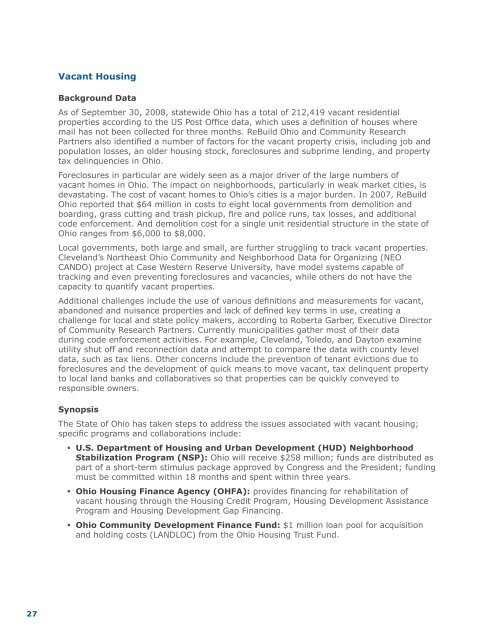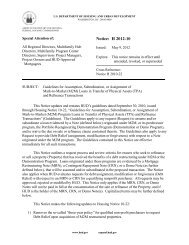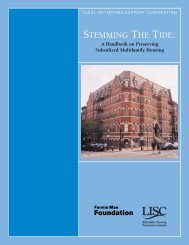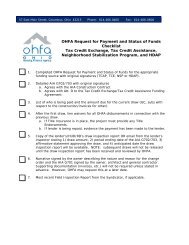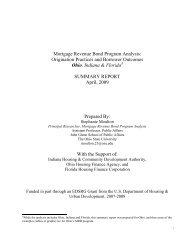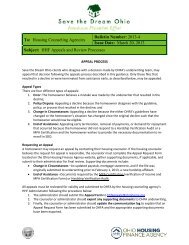OHFA Annual Plan - Ohio Housing Finance Agency
OHFA Annual Plan - Ohio Housing Finance Agency
OHFA Annual Plan - Ohio Housing Finance Agency
You also want an ePaper? Increase the reach of your titles
YUMPU automatically turns print PDFs into web optimized ePapers that Google loves.
Vacant <strong>Housing</strong>Background DataAs of September 30, 2008, statewide <strong>Ohio</strong> has a total of 212,419 vacant residentialproperties according to the US Post Office data, which uses a definition of houses wheremail has not been collected for three months. ReBuild <strong>Ohio</strong> and Community ResearchPartners also identified a number of factors for the vacant property crisis, including job andpopulation losses, an older housing stock, foreclosures and subprime lending, and propertytax delinquencies in <strong>Ohio</strong>.Foreclosures in particular are widely seen as a major driver of the large numbers ofvacant homes in <strong>Ohio</strong>. The impact on neighborhoods, particularly in weak market cities, isdevastating. The cost of vacant homes to <strong>Ohio</strong>’s cities is a major burden. In 2007, ReBuild<strong>Ohio</strong> reported that $64 million in costs to eight local governments from demolition andboarding, grass cutting and trash pickup, fire and police runs, tax losses, and additionalcode enforcement. And demolition cost for a single unit residential structure in the state of<strong>Ohio</strong> ranges from $6,000 to $8,000.Local governments, both large and small, are further struggling to track vacant properties.Cleveland’s Northeast <strong>Ohio</strong> Community and Neighborhood Data for Organizing (NEOCANDO) project at Case Western Reserve University, have model systems capable oftracking and even preventing foreclosures and vacancies, while others do not have thecapacity to quantify vacant properties.Additional challenges include the use of various definitions and measurements for vacant,abandoned and nuisance properties and lack of defined key terms in use, creating achallenge for local and state policy makers, according to Roberta Garber, Executive Directorof Community Research Partners. Currently municipalities gather most of their dataduring code enforcement activities. For example, Cleveland, Toledo, and Dayton examineutility shut off and reconnection data and attempt to compare the data with county leveldata, such as tax liens. Other concerns include the prevention of tenant evictions due toforeclosures and the development of quick means to move vacant, tax delinquent propertyto local land banks and collaboratives so that properties can be quickly conveyed toresponsible owners.SynopsisThe State of <strong>Ohio</strong> has taken steps to address the issues associated with vacant housing;specific programs and collaborations include:• U.S. Department of <strong>Housing</strong> and Urban Development (HUD) NeighborhoodStabilization Program (NSP): <strong>Ohio</strong> will receive $258 million; funds are distributed aspart of a short-term stimulus package approved by Congress and the President; fundingmust be committed within 18 months and spent within three years.• <strong>Ohio</strong> <strong>Housing</strong> <strong>Finance</strong> <strong>Agency</strong> (<strong>OHFA</strong>): provides financing for rehabilitation ofvacant housing through the <strong>Housing</strong> Credit Program, <strong>Housing</strong> Development AssistanceProgram and <strong>Housing</strong> Development Gap Financing.• <strong>Ohio</strong> Community Development <strong>Finance</strong> Fund: $1 million loan pool for acquisitionand holding costs (LANDLOC) from the <strong>Ohio</strong> <strong>Housing</strong> Trust Fund.27


